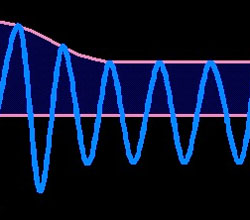
Q: I’ve heard a lot about the “crest factor” when people are discussing loudness. Does this relate at all to the issue of CD loudness in mastering?
A: It’s funny how often the term “loud” is used in the same sentence with “mastering” these days. “Real” mastering is of course much, much more than maximizing the loudness of a recording.
But loudness is an issue, regardless of whether you’re in the “more is better” camp or the “just enough” camp.
The first thing to understand about crest factor is that it is the ratio of the difference between peak level and RMS. With a pure sine wave there is a significant difference between the peak and RMS value (about 3 dB of power, but who’s counting).
So clearly more complex waveforms, such as music, are going to have differences between the RMS and peak.
For the sake of this discussion you can think of RMS as an “average” level. Though this is not entirely correct technically, it is close enough to serve our purposes.
Typically music has a crest factor of 10 to 20 dB (much more in some cases). That loosely means there is a 10 to 20 dB difference between the peak and the “average” electrical power of the music.
Now, think about what a compressor does: it decreases the dynamic range of an audio signal, usually by lowering the peaks. When this happens the crest factor is also lowered because the relative shape (amplitude) of those waveforms is necessarily changed.
When this happens there are some resulting phenomena we can observe. The most noticeable is that assuming we turn that compressed signal up to compensate for the compressor turning down those peaks the signal will now “sound” louder. This is because, on average, it is louder. The peaks are not louder, but most of the other material is.
All of the analog audio equipment in the chain is now working harder to produce this audio, and we hear the difference; the sound is much more in your face, but on our meters we may or may not notice much difference. Of course this depends on the meters.
Most of the meters most of us have access to do not make any significant distinction between compressed and uncompressed music. Given that peak reading meters are only concerned about peaks there will be no observable difference (depending of course on how far you turn things up).
Meters that attempt to give you some type of an average level will show some difference if you know what to look for, but many of those are still calibrated for “average” music, so if you push beyond this in terms of crest factor (compression) they will be inaccurate.
A true RMS meter, while expensive, will always give you an accurate reading of your levels. Anything else is a compromise.




















